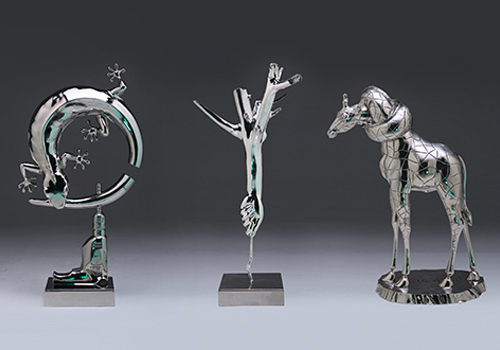2024 | Professional

Art Dealer
Entrant Company
SeeMooi Design
Category
Interior Design - Living Spaces
Client's Name
Country / Region
Taiwan
The owner of this apartment in Taipei works in China as an antique seller. Used to enjoy large spaces while working in Beijing, they have been particularly mindful of space allocation, wishing for an open and comfortable atmosphere despite the limited volumes of the dwelling.
Upon entering the apartment, the living room displays a colorful mural sculpted by the designer himself, adding depth and dimension to the room with its crafting technique. Pendant lights give the kitchen area a strong personality, creating a contemporary and textured ambiance in the whole communal space.
The absence of a fully separating wall between the master bedroom and the toilet avoids partitioning the space, making it feel wider. The murals on the dividing wall and on the outside wall echo each other, forming a panoramic Taiwanese landscape.
The staircase leading to the basement has been redesigned into a U-shape for easier accessibility. The basement stair’s handrail and structure were crafted from blue flat iron, perfectly matching the color of the master bedroom doors, and coated with rust-resistant paint. To avoid any feeling of gloominess downstairs, vibrant terrazzo tiles were selected for the basement floor. This media room displays pieces of art, just as it would in a museum. This way of exposing artworks, in the basement as well as in the whole building, reflects the owner's deep appreciation for art.
Breaking conventions, large pillars in the project became art installations, including one pillar ingeniously transformed into a wall-mounted sink.
One of the project’s biggest challenges were the pipelines, the interior architecture had to be modified slightly. The water pump was placed in the basement’s wardrobe, which supposed sacrificing a small portion of the space. This configuration allowed to pump the basement’s toilet waste upwards.
In the bathroom ceiling and on the basement walls, Japanese diatomaceous earth plaster is used for odor control, humidity and temperature regulation, but also energy conservation, an especially wise choice given the subtropical climate of the region and the pressing environmental concerns. Furthermore, it decomposes formaldehyde, is fire-resistant, and doesn’t generate static electricity, hence reduces dust accumulation.
Credits

Entrant Company
adm Design & Build (Singapore) Pte Ltd
Category
Interior Design - Office


Entrant Company
Hangzhou XIVO Design Co., Ltd.
Category
Packaging Design - Other Packaging Design


Entrant Company
UNME Design
Category
Interior Design - Office


Entrant Company
MIBO
Category
Interior Design - Exhibits, Pavilions & Exhibitions










